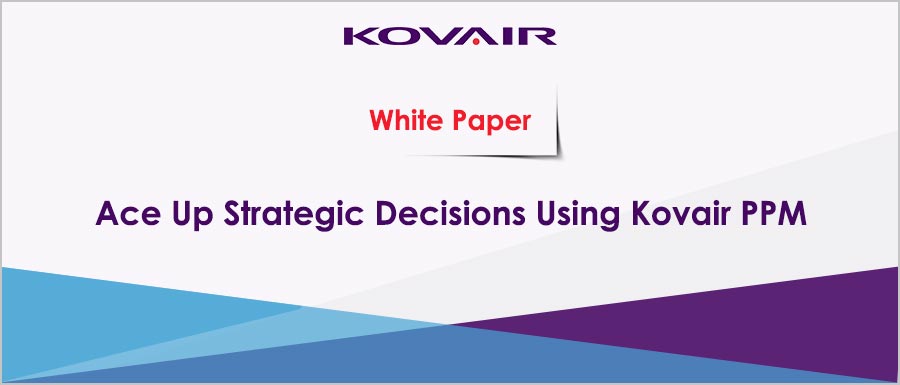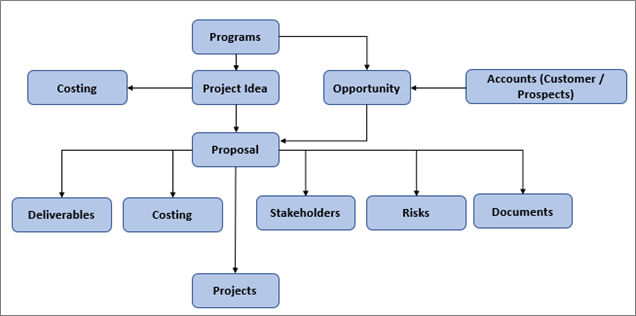
Introduction
Time, cost, and resource are the biggest management challenges in any project. Cost and effort estimation becomes a gamble without proper insights on project progress. Too often, managers make decisions based on the ongoing customer inputs or the instructions provided by business heads. It is important that decision makers get proper factual data to make the right investment decisions regarding critical information about the portfolios, projects, resources, budget, cost, and risks
- Which project to invest based on the current availability of time, budget, and resource?
- Are the project goals realistic and aligned with current IT investments?
- How to track and measure plan vs. execution details?
- How is the flow of supply of resources against the demands of resources by different Projects?
- What is the trend of risks vs ROI (Return on Investment) in the different projects undertaken to align with the strategic initiatives of the organization?
Decision making becomes extremely difficult and goes haywire if resources, time, and cost are used in wrong and unplanned initiatives. Hence portfolio decisions have to be taken based on real-time project data to avoid deadlines slippage, severe project failures and major financial loss.
Kovair Project Portfolio Management
Kovair Project Portfolio Management is a one-stop solution to optimize your project portfolios, furnish demands on available capacity, define plans, and allocate resources for project execution. Defining strategic initiatives, deciding and approving appropriate projects, providing deeper insights into projects and portfolios through Earned Value Management – EVMs, displaying health of projects in terms of cost and effort are some of the key capabilities of Kovair PPM. It provides you with real-time data and increased visibility to help you make correct investment decisions aligning with the strategic goals of the organization.
Through its single unified platform, Kovair PPM allows to manage budget, schedule, resources, and actuals, connecting the dots of planning to execution. It enables Portfolio Managers to optimize project portfolios, balance capacity against project demands, and links plans and resources to the actual project execution.
Kovair’s unified and comprehensive PPM helps you analyze and prioritize for the market in delivering quality products on time and within budget.

Bridging the Gulf of PPM and ALM
In a typical scenario, Project & Portfolio Managers use disparate systems to monitor and report on overall progress and delivery of Projects. Without synergy among these tools, consolidated and meaningful reporting becomes difficult and hence create constraints in taking portfolio decisions to address key market requirements.
Beyond PPM capabilities, Kovair also manages application lifecycle from ideation to development to delivery stages. With its built-in Application Lifecycle Management – ALM capabilities, Kovair provides an integrated PPM – ALM solution for organizations that want to manage their enterprise portfolio, projects, and products from a centralized application. Kovair PPM and ALM combined together provide an integrated work environment for managing Project, Program, Portfolio, Requirements, Test Cases, Defects, Tasks, Timesheets, Risks, Releases, Help Desk and IT operations – the end-to-end governance on portfolio, project and application lifecycle and effectively manages the ongoing micro-and macro level changes across the projects and application lifecycle as a whole.
Kovair PPM Key Features
Pre-Project Initiation Phase, Approval and Feedbacks
Kovair PPM provides complete visibility to the Portfolio of Objects – Programs, Project Ideas / Opportunities, Proposals, and Contracts. Specific users from the resource pool are assigned to the Program. On one hand it allows to gather, track and manage internal Project Ideas from various sources and on the other allows to track opportunities from external Prospects and Customers.

Entity Hierarchy at the Portfolio Level
Every Project Idea / Opportunity moves through an approval process. Kovair PPM provides Task based workflow mechanisms by which the various teams can engage to do reviews and provide approval. Kovair provides an entity management framework that allows to define appropriate entities to record all customer inputs, feedbacks, market / tech landscape, etc. while going through the execution of a Project.

Workflow for Project Idea Review and Approval
Project Planning and Recording the Time Spent
Kovair PPM has a built-in Task Scheduler that allows Project managers to create a Project Plan, allocate resources to each of the WBS items defined in the Project Plan. The Scheduler is tightly coupled with Project Calendar honoring company holidays and weekend day-offs. A visual representation of the Project Plan is replicated through the built in Gantt and Pert charts. It enables defining Task Dependencies and enable auto assignment of Planned dates of the WBS Items. It is extremely flexible in doing automatic synching of Actual Dates and Duration in Task Scheduler based on the timesheet entries done by the Task Owners and provide a single visibility to Project Manager to compare plans vs actuals.

Project Plan in Kovair Task Scheduler
Kovair PPM provides a web-based timesheet module to record time entries for individual resources. Time entries against each Task can be provided on a day-wise basis along with percentage complete to indicate the progress of work done per Task. It allows managers to manage their subordinates’ Timesheets, as well as their own. Time entries submitted, approved, or rejected are clearly depicted by different color indicators.
Kovair PPM provides a web-based timesheet module to record time entries for individual resources. Time entries against each Task can be provided on a day-wise basis along with percentage complete to indicate the progress of work done per Task. It allows managers to manage their subordinates’ Timesheets, as well as their own. Time entries submitted, approved, or rejected are clearly depicted by different color indicators.


Time Entries and Approval in Kovair Timesheet
Resource Allocation and Overloading
Kovair PPM provides a dedicated Resource Availability page that shows resource wise the no. of open Tasks, hours required to complete the open tasks, the earliest available date when the resource can be available and the list of Projects they are assigned to.

Resources Availability
During the allocation of resources, Kovair PPM automatically alerts the Project Manager when resources get overloaded. The system indicates against those WBS items for which the assigned resource got overloaded. It shows on a day wise basis, the hours of work each resource has. For example, if a resource has 8 hours of work or less in a day it is shown in green but if more than 8 hours of work is allotted to a resource, it is shown in red, indicating that the resource is overloaded.

Resources Workload by Days
Top View Management for Project Monitoring
Kovair PPM provides built-in graphical and textual reports in Word, Excel, PDF formats and dashboards with real-time drilldown data access, allowing users to configure KPIs as per organizational needs and give access to different users based on their roles and responsibilities. Dashboards in Kovair PPM can be organized to portray the health of projects running under different Programs with respect to cost and effort.



Kovair Dashboards with PPM Reports & Metrics
Business Benefits
Ensure PMO Success
Kovair PPM comes with Integrated Project Management capabilities ensuring PMO success. Starting from project initiation to project closure, all the activities are effectively and efficiently managed using Kovair PPM using EVM metrics.
Reusability
Kovair PPM functionality of project templatization provides standardization of project creation and enforces all projects belonging to a specific type follow the same structure, artifacts, and processes. It allows faster creation of projects so that the team does not have to invest much time in arranging specific objects to build the project with.
Demand & Capacity Management
Kovair PPM comes with built-in resource forecasting capability based on the project plans created by the project managers. It facilitates in the effective and optimized allocation of resources with respect to different project demands on one hand and the availability of resources on the other. It not only helps in identifying over-allocation of resources but also helps in identifying under-utilized resources.
Single Tool for Task and Time Management
Kovair PPM allows users to track their actual time spent on each of their assigned Tasks using the Timesheet module of Kovair. Once they capture their times, the actuals can be viewed against the planned hours and resource productivity as well as any delays can be seen in a real-time manner.
Support for ALM
Kovair’s PPM – ALM capabilities help organizations combine project plans with requirements management, testing, defect tracking and release data of applications. It keeps product development teams, project teams and business tied together with a single source of information. With the implementation of Kovair PPM, organizations can achieve an end-to-end traceability from Programs to Projects. Using this traceability, the portfolio managers, program managers get accurate data on coverage of various items and provide real-time status updates on the project proceedings. Kovair ALM is completely flexible in supporting various application development methodologies like Waterfall, Agile Scrum, and Kanban.
Process Automation
Omniprocess, the task-based workflow in Kovair PPM, coupled with notification and business rules, enables the project teams to implement and enforce a centralized governance across the different phases resulting in enhanced productivity and quality. It allows people working in different time zones to pass on Tasks from one to the other automatically without resorting to meetings or calls, improving their efficiency and productivity even further.
Integrated Reporting
Unlike other project management tools that offer standard timesheet reporting and project scheduling, Kovair PPM gives top-down project visibility through graphical reports and executive dashboards. The comprehensive reports entangle various stages of application development, application portfolio management, project, program and business portfolio management.
Conclusion
Kovair PPM has helped some large organizations successfully implement a complete Portfolio and Project Management environment. With this implementation, organizations have seen a substantial growth both in quality, productivity and management awareness and real time visibility with easy access to reports and drill down dashboards features built into Kovair. To know more about Kovair products visit www.kovair.com




